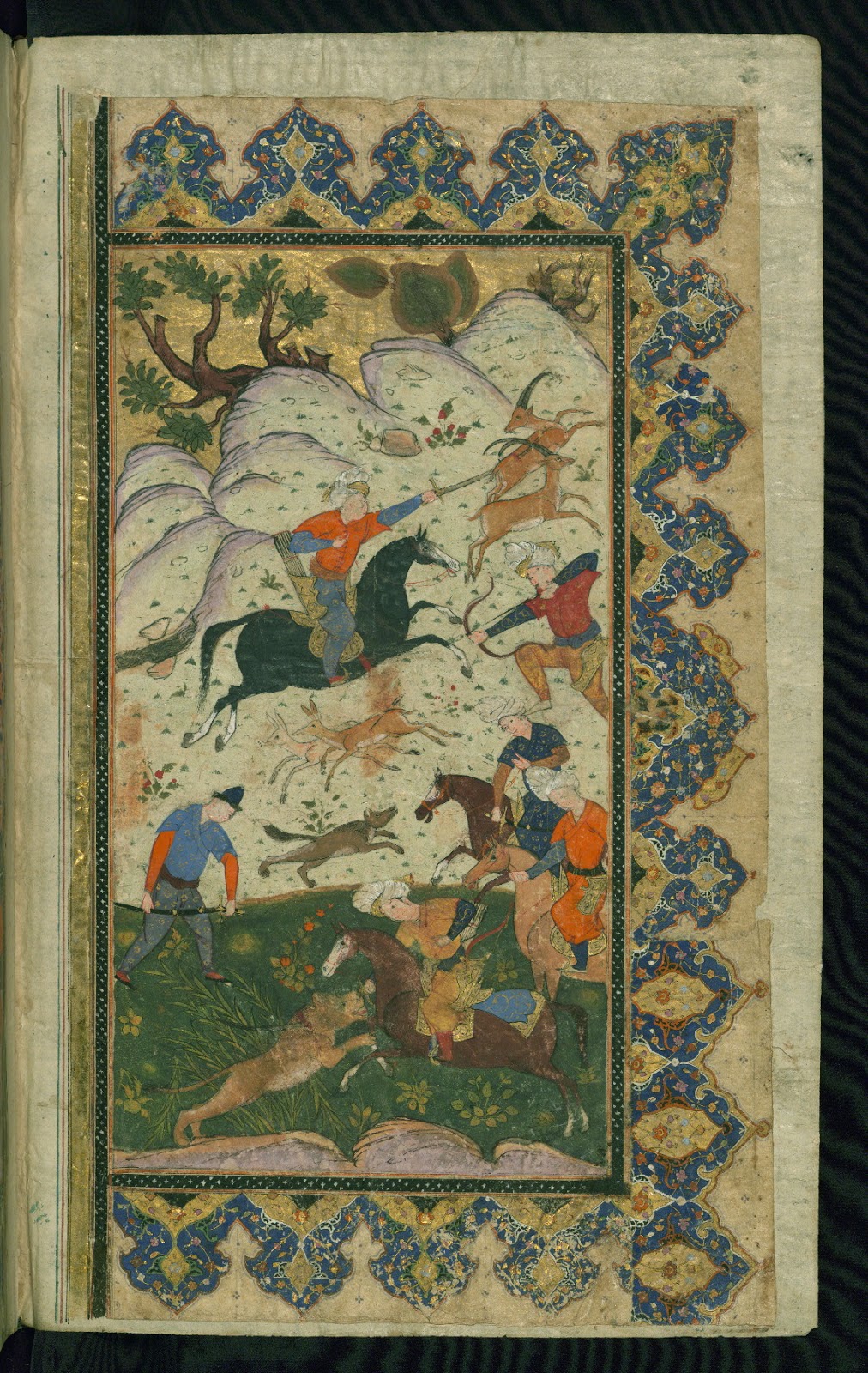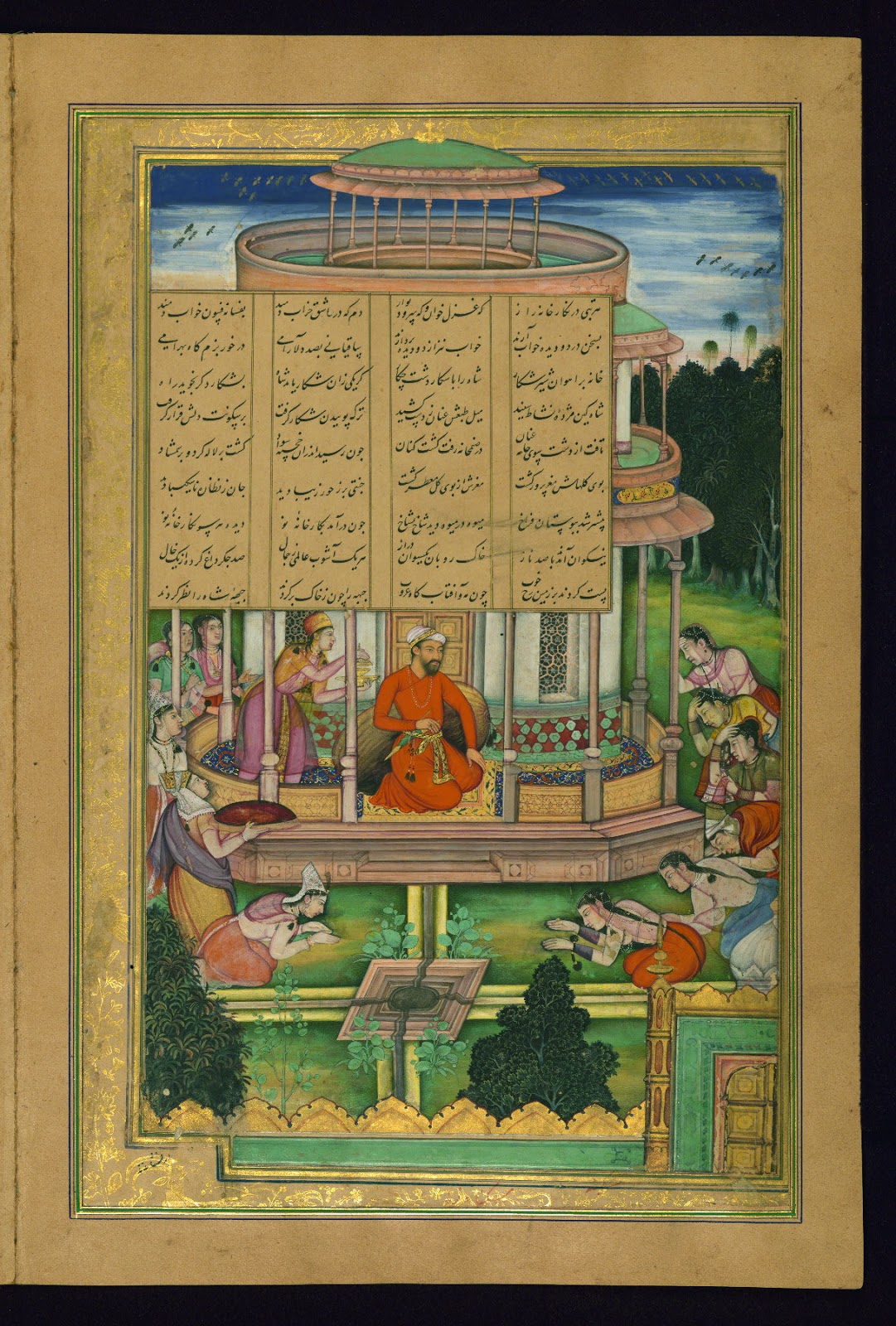Khamsah of Amīr Khusraw Dihlavī امير خسرو دهلوى
This is the Khamsah (quintet) of Amīr Khusraw Dihlavī امير خسرو دهلوى(d. 725 AH / 1325 CE). The manuscript was written in nastaʿlīq script by one of the greatest calligraphers of the Mughal atelier, Muḥammad Ḥusayn al-Kashmīrī, honored with the epithet Zarrīn Qalam (golden pen). This copy of Dihlavī's Khamsah, likely produced in Lahore (present-day Pakistan) in the late tenth century AH / sixteenth CE, is associated with the patronage of Akbar (r. 963-1014 AH / 1556-1605 CE). The manuscript bears the names of a number of painters and illuminators. The illustrations bear ascriptions to the following artists: Laʿl (Lāl), Manūhar, Sānwalah, Farrukh, Alīqulī, Dharamdās, Narsing, Jagannāth, Miskīnā, Mukund, and Sūrdās Gujarātī. The illuminators are Ḥusayn Naqqāsh, Manṣūr Naqqāsh, Khvājah Jān Shīrāzī, and Luṭf Allāh Muẕahhib. The borders are all elaborately illuminated with animal, bird, and geometric motifs, as well as human figures engaged in such activities as hunting, praying, and reading.
Alexander_the_Great_visits_Plato_in_his_cave
Alexander_the_Great_lassos_a_Chinese_warrior
Bahrām_Gūr_recognizes_Dilārām_by_the_music
with_which_she_enchants_the_animals
Both_Shīrīn_and_Khusraw_celebrate_their_upcoming_nuptials
in_their_respective_pavilions._Below_the_image_and
written_in_red_is_ʿamal-i_(the_work_of)_Farrukh_(Chela)
Alexander_the_Great_(Iskandar)_searches_for_the_Fountain_of_Life
which_is_made_invisible_by_the_prophets_Khizr_and_Ilyās.
Alexander_the_Great_entertains_Kanīfū
Bahrām_Gūr_in_the_sandalwood_pavilion
Bahrām_Gūr_in_the_white_pavilion
Khusraw_discusses_his_dream_with_Buzurg_Umīd
Khusraw_makes_love_to_Shīrīn
Laylá_and_Majnūn_fall_in_love_at_school
Laylá_and_Majnūn,_the_ill-fated_lovers,_are_depicted_at_school_as_youths.
ʿAmal-i_Dharamdās_is_inscribed_in_the_border
Khusraw_and_Shīrīn_are_entertained_at_their_wedding
Alexander_the_Great_(Iskandar)_invents_a_mirror_that,
when_mounted_on_a_tower,_shows_everything_within
a_radius_of_60_farsangs_and_thus_enables_Alexander’s
men_to_attack_marauding_pirates
Bahrām_Gūr_in_the_green_pavilion
A_court_scene
A_king_out_hunting,_having_accidentally_killed_a_youth,
offers_the_boy's_mother_his_life_or_a_platter_of_gold.
A_school_scene
Alī_kills_an_infidel_who_had_spat_in_his_face
Bahrām_Gūr_displays_his_hunting_skills_before_Dilārām
Bahrām_Gūr_in_the_blue_pavilion
Farhād_is_shown_in_great_sorrow_as_he_is_told_that_Shīrīn_has_died.
It_is_Khusraw,_in_disguise,_who_relates_this_untruth.
Illuminated_finispiece
Illuminated_headpiece_introduces_the_second_poem_of
the_Khamsah,_Shīrīn_va_Khusraw._It_is_signed_by
Khvājah_Jān_Shīrāzī_in_the_small_cartouches_flanking_the
white_border_that_defines_the_large_illuminated_rectangle
A_court_scene
Alexander_the_Great's_army_carries_his_casket_back_to_Greece
Buzurg_Umīd_tells_Khusraw_the_story_of_a_king’s
punishment_of_a_rude_messenger
Majnun_is_shown_holding_a_stray_dog_found_near_Laylá's_home.
Majnūn’s_father_brings_him_to_his_family
Majūn,_emaciated_and_living_with_the_beasts_of_the_wilderness,
is_visited_by_his_father._Inscribed_in_red_ink
below_the_image_is_ʿamal-i_(work_of)_Laʿl.
is_visited_by_his_father._Inscribed_in_red_ink
below_the_image_is_ʿamal-i_(work_of)_Laʿl.
Nawfal_battles_Laylá’s_clan_on_behalf_of_Majnūn
On_horseback,_Shīrīn_approaches_the_sculptor_Farhād.
The_milk_flowing_through_the_channel_recalls_Shīrīn's
request_that_Farhād_cut_a_path_through_the_mountain_to
bring_milk_from_his_flocks_to_her_pavilion.
The_milk_flowing_through_the_channel_recalls_Shīrīn's
request_that_Farhād_cut_a_path_through_the_mountain_to
bring_milk_from_his_flocks_to_her_pavilion.
Scenes_from_the_wintry_period_in_India_(December_and_January)
Shāh_Jahān_returns_to_his_court_in_India
Sultan_Muʿizz_al-Dīn_is_reconciled_with
his_father,_Naṣīr_al-Dīn_Bughrā_Khān
his_father,_Naṣīr_al-Dīn_Bughrā_Khān
The_Greeks_are_punished_for_not_accepting
the_faith_and_rule_of_Alexander_the_Great.
the_faith_and_rule_of_Alexander_the_Great.
The_ill-fated_lovers_Majnūn_and_Laylá_meet
in_the_wilderness_surrounded_by_the_beasts_befriended_by_Majnun.
ʿAmal-i_(work_of)_Narsing_is_inscribed_in_red_below_the_image.
in_the_wilderness_surrounded_by_the_beasts_befriended_by_Majnun.
ʿAmal-i_(work_of)_Narsing_is_inscribed_in_red_below_the_image.
The_Khāqān_of_China_prostrates_himself_before
Alexander_the_Great._The_gifts_offered_to_the_latter
are_seen_in_the_foreground.
Alexander_the_Great._The_gifts_offered_to_the_latter
are_seen_in_the_foreground.
The_Khāqān_of_China_receives_a_letter_from_Alexander
the_Great_(Iskandar)_demanding_his_surrender.
the_Great_(Iskandar)_demanding_his_surrender.
This incipit page has an illuminated titlepiece inscribed
Kitāb Matla al-anvār min Khamsat Amīr Khusraw alayhi al-rahmah.
There is interlinear decoration of gilt and polychrome floral motifs
and an outer illuminated border.
Kitāb Matla al-anvār min Khamsat Amīr Khusraw alayhi al-rahmah.
There is interlinear decoration of gilt and polychrome floral motifs
and an outer illuminated border.
This_incipit_page_with_illuminated_headpiece_introduces
the_fifth_poem_of_the_Khamsah,_Hasht_bihisht.
It_is_signed_by_Ḥusayn_(Naqqāsh).
the_fifth_poem_of_the_Khamsah,_Hasht_bihisht.
It_is_signed_by_Ḥusayn_(Naqqāsh).
This_incipit_page_with_illuminated_headpiece_introduces
the_third_poem_of_the_Khamsah,_Majnūn_va_Laylá.
It_is_signed_ʿamal-i_Luṭf_Allāh_muẕahhib.
the_third_poem_of_the_Khamsah,_Majnūn_va_Laylá.
It_is_signed_ʿamal-i_Luṭf_Allāh_muẕahhib.
This_is_the_illuminated_frontispiece_to_the_second_poem_of_the_Khamsah,
Shīrīn_va_Khusraw._It_is_signed_ʿamal-i_Ḥusayn_Naqqāsh.
Shīrīn_va_Khusraw._It_is_signed_ʿamal-i_Ḥusayn_Naqqāsh.
This_is_the_left_side_of_a_double-page_illuminated
and_illustrated_frontispiece_of_the_Khamsah-i_Dihlavī.
and_illustrated_frontispiece_of_the_Khamsah-i_Dihlavī.
This_is_the_right_side_of_a_double-page_illuminated
and_illustrated_frontispiece_of_the_Khamsah-i_Dihlavī.
and_illustrated_frontispiece_of_the_Khamsah-i_Dihlavī.
This_is_the_story_of_the_princess_in_the_red_pavilion.
A_prince_befriends_an_old_woman_in_order_to_gain_access
to_the_tower_and_abduct_his_beloved.
A_prince_befriends_an_old_woman_in_order_to_gain_access
to_the_tower_and_abduct_his_beloved.
This_pavilion_scene_depicts_the_Armenian_princess
Shīrīn_welcoming_Khusraw_in_Armenia.
The_illustration_is_the_work_of_(ʿamal-i)_Manūhar.
Shīrīn_welcoming_Khusraw_in_Armenia.
The_illustration_is_the_work_of_(ʿamal-i)_Manūhar.
This illustration depicts the twentieth maqāla (discourse),
which emphasizes female virtue. The king relentlessly pursues
the female protagonist, claiming that he cannot resist her beautiful eyes.
To escape his amorous advances, the woman plucks out her eyes
and sends them to him. She thus chooses virtue over all else, even her ability to see.
which emphasizes female virtue. The king relentlessly pursues
the female protagonist, claiming that he cannot resist her beautiful eyes.
To escape his amorous advances, the woman plucks out her eyes
and sends them to him. She thus chooses virtue over all else, even her ability to see.
When_the_brave_captive_Chinese_warrior_Kanīfū_is_stripped_of_armor,
Alexander_the_Great_and_his_retinue_are_amazed_to_discover_that_the_warrior_is_a_woman.
Alexander_the_Great_and_his_retinue_are_amazed_to_discover_that_the_warrior_is_a_woman.
This_garden_scene_relates_the_seventeenth_maqāla_(discourse).
An_elderly_sufi_makes_a_romantic_gesture_toward_a_young_handsome
man_in_an_orange_jama._This_illustration_is_the_work_of_ʿamal-i_Laʿl_(Lāl).
An_elderly_sufi_makes_a_romantic_gesture_toward_a_young_handsome
man_in_an_orange_jama._This_illustration_is_the_work_of_ʿamal-i_Laʿl_(Lāl).
This_illustration_depicts_one_of_the_many_battles_fought
by_Alexander_the_Great,_who_is_celebrated_in_the_Islamic
tradition_as_one_of_the_great_historic_rulers._The_painting
is_inscribed_Jagannāth_in_red_ink.
by_Alexander_the_Great,_who_is_celebrated_in_the_Islamic
tradition_as_one_of_the_great_historic_rulers._The_painting
is_inscribed_Jagannāth_in_red_ink.
This illustration depicts the story of two divs (demons)
who, out of boredom, wreak havoc on the world.
Recognizing the dangers of idleness, the wise King Solomon
consigns them to a life of futile activity: filling the sea with sand
and the desert with water. The inscription naming the artist
‘Ali Quli is composed in red ink at the bottom of the page.
who, out of boredom, wreak havoc on the world.
Recognizing the dangers of idleness, the wise King Solomon
consigns them to a life of futile activity: filling the sea with sand
and the desert with water. The inscription naming the artist
‘Ali Quli is composed in red ink at the bottom of the page.
This_illustration_depicts_the_tenth_maqāla_(discourse).
Two_men_who_are_about_to_be_executed_are_found_in_the
lower_foreground._Several_men_plea_to_the_king_for_clemency.
Two_men_who_are_about_to_be_executed_are_found_in_the
lower_foreground._Several_men_plea_to_the_king_for_clemency.
The union of ten couples had been arranged by Khusraw,
who sits with Shīrīn in celebration. In the spirit of the happy ceremony,
Khusraw asks Shīrīn to marry him. Although in love with him,
the Armenian princess declines. The inscription in red in the border
reads ʿamal-i (the work of) Sānwalah.
who sits with Shīrīn in celebration. In the spirit of the happy ceremony,
Khusraw asks Shīrīn to marry him. Although in love with him,
the Armenian princess declines. The inscription in red in the border
reads ʿamal-i (the work of) Sānwalah.
This incipit page has an illuminated titlepiece inscribed
Kitāb Maṭla al-anvār min Khamsat Amīr Khusraw
alayhi al-raḥmah. There is interlinear decoration of gilt and
polychrome floral motifs and an outer illuminated border.
Kitāb Maṭla al-anvār min Khamsat Amīr Khusraw
alayhi al-raḥmah. There is interlinear decoration of gilt and
polychrome floral motifs and an outer illuminated border.
This illustration depicts the story told to Bahram Gūr
by the princess of the sandalwood pavilion. The young prince
who was wrongfully accused of incest follows the advice
of three friends to exonerate himself. He is shown meditating
upon a statue, as instructed. At the bottom of the page
is inscribed ʿamal-i (the work of) Mukund.
by the princess of the sandalwood pavilion. The young prince
who was wrongfully accused of incest follows the advice
of three friends to exonerate himself. He is shown meditating
upon a statue, as instructed. At the bottom of the page
is inscribed ʿamal-i (the work of) Mukund.
This illustration depicts the story told to Bahram Gūr by
the princess of the white pavilion. It is a tale of a king
on a quest for a sincere woman to marry. He is given a talisman
to help him in his search. The talisman laughs whenever
a woman is insincere. In this image, the gold statue laughs
as a woman pretends to faint. Below the image is
inscribed ʿamal-i (work of) Sūrdās Gujarātī.
the princess of the white pavilion. It is a tale of a king
on a quest for a sincere woman to marry. He is given a talisman
to help him in his search. The talisman laughs whenever
a woman is insincere. In this image, the gold statue laughs
as a woman pretends to faint. Below the image is
inscribed ʿamal-i (work of) Sūrdās Gujarātī.
The princesses of the seven pavilions bow before Bahram Gur.
Each of them will lead Bahram on a journey from a pleasure-seeking
prince to a wise and just king. This illustration is the
work of Miskīnā and Farrukh.
Each of them will lead Bahram on a journey from a pleasure-seeking
prince to a wise and just king. This illustration is the
work of Miskīnā and Farrukh.
The_prophet_Khizr_paying_a_visit_to_a_pious_man



%2BFarrukh%2B(Chela)..jpg)
%2Bsearches%2Bfor%2Bthe%2BFountain%2Bof%2BLife%2Bwhich%2Bis%2Bmade%2Binvisible%2Bby%2Bthe%2Bprophets%2BKhiz%CC%A4r%2Band%2BIly%C4%81s..jpg)








%2Binvents%2Ba%2Bmirror%2Bthat%2C%2Bwhen%2Bmounted%2Bon%2Ba%2Btower%2C%2Bshows%2Beverything%2Bwithin%2Ba%2Bradius%2Bof%2B60%2Bfarsangs%2Band%2Bthus%2Benables%2BAlexander%E2%80%99s%2Bmen%2Bto%2Battack%2Bmarauding%2Bpirates..jpg)















%2BLa%CA%BFl..jpg)


.jpg)



%2BNarsing%2Bis%2Binscribed%2Bin%2Bred%2Bbelow%2Bthe%2Bimage..jpg)

%2Bdemanding%2Bhis%2Bsurrender..jpg)

..jpg)





%2BMan%C5%ABhar..jpg)


.%2BAn%2Belderly%2Bsufi%2Bmakes%2Ba%2Bromantic%2Bgesture%2Btoward%2Ba%2Byoung%2Bhandsome%2Bman%2Bin%2Ban%2Borange%2Bjama.%2BThis%2Billustration%2Bis%2Bthe%2Bwork%2Bof%2B%CA%BFamal-i%2BLa%CA%BFl%2B(L%C4%81l)..jpg)

%2Bwho%2C%2Bout%2Bof%2Bboredom%2C%2Bwreak%2Bhavoc%2Bon%2Bthe%2Bworld.%2BRecognizing%2Bthe%2Bdangers%2Bof%2Bidleness%2C%2Bthe%2Bwise%2BKing%2BSolomon%2Bconsigns%2Bthem%2Bto%2Ba%2Blife%2Bof%2Bfutile%2Bactivity.jpg)
.%2BTwo%2Bmen%2Bwho%2Bare%2Babout%2Bto%2Bbe%2Bexecuted%2Bare%2Bfound%2Bin%2Bthe%2Blower%2Bforeground.%2BSeveral%2Bmen%2Bplea%2Bto%2Bthe%2Bking%2Bfor%2Bclemency..jpg)









.JPG)
.jpg)
.jpg)



.jpg)
0 comments:
Post a Comment